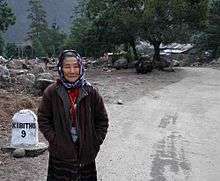Zakhring language
| Zakhring | |
|---|---|
| Meyor | |
| Native to | India |
| Region | Arunachal |
| Ethnicity | Zekhring people |
Native speakers | 900 (2002–2007)[1] |
|
Sino-Tibetan
| |
| Language codes | |
| ISO 639-3 |
zkr |
| Glottolog |
zakh1243[2] |

[3]Zahkring (also Eastern Mishmi, Zaiwa, or Meyor) is a small Sino-Tibetan language of Arunachal Pradesh in India.
Zakhring has been classified as a Midzuish language.[4] However, it appears that Midzu may not be Sino-Tibetan, whereas Zakhring clearly is. Blench and Post (2011) think that it is an East Bodish language that has been influenced by Midzu or other divergent languages of the region.[5]
A closely related language called Zha (Zhahua 扎话) is spoken in China.[6]
Landi (2005:164) also notes that Zakhring has some surprising similarities to Miju.
Mridul Chakravorty (2015):"The Zakhring Community of Arunachal Pradesh: Notes on a Lost Tribe," Space and
Culture, India, vol 2, No 3, pp 94-101. discuss about their ethnography. The zakhring mixed with Charumba and Mishmi were presently know as Meyor, which literally mean farmer. But they were called as Zakhring by the people on the north behind the borders.
Names
Li (2001)[7] reports that the Zakhring have no actual autonym, but are referred to by the neighboring Taraon, Kaman, Idu, and Tibetan peoples by various names.
- tɕa31 khreŋ55 (Taraon exonym)
- tɕa31 khɹɯn55 (Kaman exonym)
- tsa35 tɕoŋ55 (Tibetan exonym)
- mi31 si55 pu53 (Idu exonym; the Idu are located in Upper Zayü Township 上察隅乡)
Kaman exonym for the Tibetan people of Bomi County 波密县 is si31 dut55 pu55. The Taraon refer to the Tibetans as la31 ma35, while the Kaman refer to the Tibetans as de31 loŋ55.
Distribution
In China, Zakhring is spoken in Songgu 松古村, Lading 拉丁村, and Tama 塔玛村 villages in Lower Zayü Township 下察隅乡, Zayü County 察隅县, Tibet.[1]
In India, Meyor communities are found in the following 15 villages of Kibthoo Circle and Walong Circle of Anjaw District, Arunachal Pradesh. The total population of the villages numbered 376 as of May 2001 (Landi 2005:1).
- Kibthoo Circle
- 1.Kahao
- 2. Mosai
- 3. Danbari
- 4. Kundan
- 5. Khroti
- 6. Yaikung
- 7. Bara Kundan 8.Kunjuk
- Walong Circle
- 1.Walong
- 2. Tinai
- 3. Dong
- 4. Tilam
- 5. Sapkung
- 6. Pangung
References
- 1 2 Zakhring at Ethnologue (18th ed., 2015)
- ↑ Hammarström, Harald; Forkel, Robert; Haspelmath, Martin; Bank, Sebastian, eds. (2016). "Zakhring". Glottolog 2.7. Jena: Max Planck Institute for the Science of Human History.
- ↑ Chakravorty, Mridul Kumar (2015-11-08). "The Zakhring Community of Arunachal Pradesh: Notes on a Lost Tribe". Space and Culture, India. 3 (2): 94–102. doi:10.20896/saci.v3i2.152. ISSN 2052-8396.
- ↑ George van Driem (2001) Languages of the Himalayas: An Ethnolinguistic Handbook of the Greater Himalayan Region. Brill.
- ↑ Blench, Roger; Post, Mark (2011), (De)classifying Arunachal languages: Reconstructing the evidence (PDF)
- ↑ Li Daqin & Jiang Di 李大勤,江荻 2001. 扎语概况 [Brief introduction of Zha speech]. 民族语文 Minority Languages of China 2001(6): 61-75.
- ↑ Li Daqin [李大勤]. 2001. "A sketch of Zha" [扎话概况]. Minzu Yuwen 2001:6.
- Landi, Victor 2005. The Meyors and their language. Itanagar: Directorate of Research, Arunachal Pradesh Government.